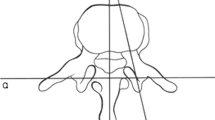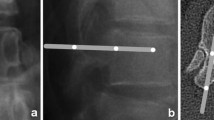Abstract
Purpose
Pedicle screw instrumentation has superior biomechanical as well as clinical outcome. Thoracic pedicles show great variation in different population groups, particularly in Asians who have been shown to have smaller pedicle dimensions. Although plain radiographs are widely performed prior to spine surgery, no studies have been done so far to investigate whether the thoracic pedicle profile on plain radiographs affect thoracic pedicle screw insertion. Therefore, this is a cadaveric study aimed to determine the relationship between plain radiographic thoracic pedicle profile in Asians and the outcome of pedicle screw insertion in the thoracic spine.
Methods
A pre-insertion radiograph with an enlargement reference scale was performed and surgeons were blinded to the plain radiographic morphometry of the thoracic pedicles. From the pre-insertion radiograph, the normalized pedicle width and height (which controls for any magnification error) as well as the pedicle width:body width (PWBW) and pedicle width:pedicle height (PWPH) ratio was derived. 240 pedicle screws were inserted in ten Asian cadavers from T1 to T12 using the funnel technique. 5.0 mm screws were used from T1 to T6 while 6.0 mm screws were used from T7 to T12. Perforations were detected by direct visualization via wide laminectomies after pedicle screw insertion. The outcome of thoracic pedicle screw insertion was correlated with the radiological profile using independent t-test. Pearson correlation coefficient was used to investigate the correlation between the ratios and the normalised pedicle width and height.
Results
The narrowest pedicle width is from T3 to T6 determined from normalized measurement of the pedicle width. T5 pedicle width is the smallest measuring 4.1 ± 1.3 mm. The overall perforation rate is 10.4% (25 perforations). There is only one significant perforation. There were twice as many lateral and inferior perforations compared to the medial perforations. 48% of the perforations occurred at T1, T2 and T3. Pedicles <4.0 mm in width and upper thoracic pedicles are risk factors for pedicle perforation. The normalised pedicle width has a high degree of linear correlation with PWBW and a normalised pedicle width of 4.0 mm correlated with a PWBW ratio of 0.3.
Conclusions
Plain radiographic thoracic pedicle morphometry has an influence on the outcome of thoracic pedicle screw insertion in Asian cadavers. Pedicle width <4.0 mm is associated with higher risk of pedicle perforation. This critical value corresponds to a PWBW ratio of 0.3. Identification of such pedicle profile warrants full evaluation of the morphometry of the thoracic pedicles and possibly extra-pedicular techniques should be employed to avert the risk of critical pedicle perforation.






Similar content being viewed by others
References
Belmont PJJ, Klemme WR, Dhawan A, Polly DWJ (2001) In vivo accuracy of thoracic pedicle screws. Spine 26–21:2340–2346
Boucher HH (1959) A method of spinal fusion. J Bone Joint Surg Br 41:248–259
Cahill P, Rinella AS, Ghanayem A et al (2004) Thoracic pedicle expansion after pedicle screw insertion in a pediatric cadaveric spine: a biomechanical analysis. Spine J 4:S93
Cinotti G, Gumina S, Ripani M et al (1999) Pedicle instrumentation in the thoracic spine: a morphometric and cadaveric study for placement of screws. Spine 24:114–119
Dobbs MB, Lenke LG, Kim YJ et al (2006) Selective posterior thoracic fusions for adolescent idiopathic scoliosis: comparison of hooks versus pedicle screws. Spine 31:2400–2404
Dobbs MB, Lenke LG, Kim YJ et al (2006) Anterior/posterior spinal instrumentation versus posterior instrumentation alone for the treatment of adolescent idiopathic scoliotic curves more than 90°. Spine 31:2386–2391
Ebraheim NA, Jabaly G, Xu R et al (1997) Anatomic relations of the thoracic pedicle to adjacent neural structures. Spine 22:1553–1557
Gaines RW (2000) Current concepts review: the use of pedicle-screw internal fixation for the operative treatment of spinal disorders. J Bone Joint Surg Am 82:1458–1476
Kim YJ, Lenke LG, Bridwell KH, Cho YS, Riew KD (2004) Free hand pedicle screw placement in the thoracic spine: is it safe? Spine 29:333–342
Kim YJ, Lenke LG, Cho SK et al (2004) Comparative analysis of pedicle screw versus hook instrumentation in posterior spinal fusion of adolescent idiopathic scoliosis. Spine 29:2040–2048
Kim YJ, Lenke LG, Kim J et al (2006) Comparative analysis of pedicle screw versus hybrid instrumentation in posterior spinal fusion of adolescent idiopathic scoliosis. Spine 31:291–298
Korovessis P, Baikousis A, Zacharatos S et al (2006) Combined anterior plus posterior stabilization versus posterior short-segment instrumentation and fusion for mid-lumbar (L2–L4) burst fractures. Spine 31:859–868
Liljenqvist UR, Halm HFH, Link TM (1997) Pedicle screw instrumentation of the thoracic spine in idiopathic scoliosis. Spine 22:2239–2245
Luhmann SJ, Lenke LG, Kim YJ et al (2005) Thoracic adolescent idiopathic scoliosis curves between 70° and 100°: is anterior release necessary? Spine 30:2061–2067
McCormack BM, Benzel EC, Adams MS et al (1995) Anatomy of the thoracic pedicle. Neurosurgery 37:303–308
Morgenstern W, Ferguson SJ, Berey S et al (2003) Posterior thoracic extrapedicular fixation: a biomechanical study. Spine 28:1829–1835
Panjabi MM, Takata K, Goel V et al (1991) Thoracic human vertebrae: quantitative three-dimensional anatomy. Spine 16:888–901
Parker JW, Lane JR, Karaikovic EE et al (2000) Successful short-segment instrumentation and fusion for thoracolumbar spine fractures: a consecutive 4½-year series. Spine 25:1157–1170
Rajasekaran S, Vidyadhara S, Perumal M et al (2007) Randomized clinical study to compare the accuracy of navigated and non-navigated thoracic pedicle screws in deformity correction surgeries. Spine 32:E56–E64
Rao G, Brodke DS, Rondina M et al (2002) Comparison of computerized tomography and direct visualization in thoracic pedicle screw placement. J Neurosurg 97(Suppl 2):223–226
Scoles PV, Linton AE, Latimer B et al (1988) Vertebral body and posterior element morphology: the normal spine in middle life. Spine 13:1082–1086
Smorgick Y, Milgram MA, Anekstein Y, Floman Y, Mirovsky Y (2005) Accuracy and safety of thoracic pedicle screw placement in spinal deformities. Spine 18:522–526
Suk S, Kim WJ, Lee SM et al (2001) Thoracic pedicle screw fixation in spinal deformities: are they really safe? Spine 26:2047–2059
Suk S, Lee S, Chung E et al (2003) Determination of distal fusion level with segmental pedicle screw fixation in single thoracic idiopathic scoliosis. Spine 28:484–491
Tan SH, Teo EC, Chua HC (2004) Quantitative three dimensional anatomy of cervical, thoracic and lumbar vertebrae in Chinese Singaporean. Eur Spine J 13:137–146
Thanapipatsiri S, Meknavin S, Chavisiri C, Unnanantana A, Chotigavanich C (1996) Pedicle sizes of the thoracic vertebrae from T1 to T12 in thai adults. J Asean Orthop Assoc 10:5–8
Ugur HÇ, Attar A, Uz A et al (2001) Thoracic pedicle: surgical anatomic evaluation and relations. J Spinal Disord 14:39–45
Vaccaro AR, Rizzolo SJ, Balderston RA et al (1995) Placement of pedicle screws in the thoracic spine. Part 2: an anatomical and radiographic assessment. J Bone Joint Surg Am 77:1200–1206
White KK, Oka R, Mahar AT et al (2006) Pullout strength of thoracic pedicle screw instrumentation: comparison of the transpedicular and extrapedicular techniques. Spine 31:E355–E358
Yingsakmonkol W, Karaikovic E, Gaines RW (2002) The accuracy of pedicle screw placement in the thoracic spine using the “funnel technique”: part 1 A cadaveric study. J Spinal Disord 15:445–449
Yue JJ, Sossan A, Selgrath C et al (2002) The treatment of unstable thoracic spine fractures with transpedicular screw instrumentation: a 3-year consecutive series. Spine 27:2782–2787
Zindrick MR, Wiltse LL, Doornik A et al (1987) Analysis of morphometric characteristics of the thoracic and lumbar pedicles. Spine 12:160–166
Author information
Authors and Affiliations
Corresponding author
Rights and permissions
About this article
Cite this article
Chan, C.Y.W., Kwan, M.K. & Saw, L.B. Thoracic pedicle screw insertion in Asian cadaveric specimen: does radiological pedicle profile affect outcome?. Surg Radiol Anat 33, 19–25 (2011). https://doi.org/10.1007/s00276-010-0726-1
Received:
Accepted:
Published:
Issue Date:
DOI: https://doi.org/10.1007/s00276-010-0726-1




